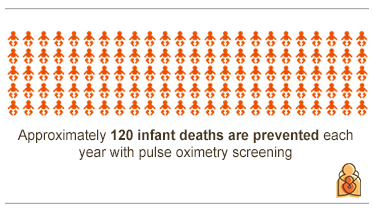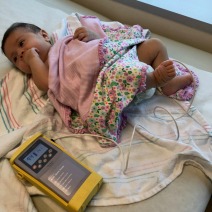By: Alex R. Kemper, MD, MPH, MS, FAAP
Most babies are born with healthy hearts that pump oxygen-rich blood from the lungs to every cell in the body. However, about 1 baby in every 100 is born with a
congenital heart defect (CHD). This means the heart did not form correctly. And of babies born with CHD, 1 in 4 will have a "critical" heart defect or
critical congenital heart disease (CCHD). CCHD leads to levels of oxygen in the blood that are too low.
Because low blood oxygen can result in life-threatening complications, babies with CCHD usually need surgery or other procedures in the first year of life. Sometimes, they need these procedures more urgently—within the first days or weeks of birth.
What is pulse oximetry?

There are types of CCHD that cause lower than usual blood oxygen levels. Those can be picked up by a test called
pulse oximetry―even before a baby becomes sick.
Pulse oximetry (also called pulse ox) is a simple way to measure the level of oxygen in the blood using sensors placed on the skin.
Why we recommend newborn pulse ox screening
The American Academy of Pediatrics (AAP) recommends pulse oximetry be performed at all newborn screenings to detect CCHD.
Identifying CCHD before the baby leaves the hospital or birth center can prevent dangerous problems after going home. It also makes early management and treatment possible, which can lead to better outcomes. Each state has a requirement for newborn pulse oximetry screening.
In this video, learn more about how pulse oximetry screening helps identify dangerous heart conditions in newborns before they leave the hospital:
Fetal ultrasounds of the heart do not detect all types of heart defects
Many problems in the fetal heart are now found early by fetal ultrasounds, and families are getting referred earlier to
pediatric cardiologists for further care. Still, there are still cases of CHD that can be missed.
Many newborns develop signs of CCHD such as turning blue or breathing fast right after birth. Those babies are diagnosed and treated before being discharged from the hospital. However, there are babies with CCHD who may look and act healthy for several days before becoming suddenly seriously ill at home.
How is newborn pulse ox screening done?

A small soft sensor is wrapped around the baby's right hand and one foot. The sensor is hooked up to a monitor for about 5 minutes. It measures the oxygen level in the blood and the heart rate.
The test is fast, easy, and does not hurt. Pulse oximetry screening is done after 24 hours after birth to allow the baby's heart and lungs to fully adjust to life outside the womb. Results are ready as soon as the screening in done.
What happens if a baby has an abnormal pulse oximetry screening?
If the screening test suggests a problem, additional testing is needed. These can evaluate for CHD or other potential causes of low oxygen are needed before the baby is discharged from the hospital.
Testing may include a chest radiography and bloodwork. An ultrasound of the baby's heart, called an echocardiogram, may be performed and read by a pediatric cardiologist.
The echocardiogram will evaluate all the structures and function of the baby's heart in detail. If the baby's echocardiogram shows any problems, the baby's medical team will discuss next steps with the parents. See "Common Types of Cardiac Testing."
As with any screening test, the pulse oximetry screening test is not always correct. Sometimes here can be false positives, meaning that while the pulse ox screen suggests a problem, the heart is normal.
Just because a baby has an abnormal pulse oximetry screening test does not mean that the baby has a heart defect.
There are other reasons that a baby may have lower oxygen levels, such as infection or lung problems. These can also be important to be picked up early. Some healthy babies can have a low pulse oximetry reading while their heart and lungs are adjusting to the changes that happen after birth.
If a baby passes the pulse oximetry screening, does it mean there are no heart defects?
Unfortunately, no. Pulse oximetry testing picks up only some types of CHD. Heart defects that are not causing a low blood oxygen level at the time of the screen are not picked up by the test.
Even if a baby passes the pulse oximetry screening, parents should watch for:
Problems feeding
Difficulty in breathing, fast breathing, or grunting
Irritability
Excessive sleepiness
Bluish color to the lips or skin
Poor weight gain
Contact your baby's doctor right away if you notice any of these signs.
More information
About Dr. Kemper
 Alex R. Kemper, MD, MPH, MS, FAAP, who serves on the AAP Councils on Clinical Information Technology and Quality Improvement and Patient Safety, is Division Chief of Primary Care Pediatrics at Nationwide Children's in Columbus, Ohio. Alex R. Kemper, MD, MPH, MS, FAAP, who serves on the AAP Councils on Clinical Information Technology and Quality Improvement and Patient Safety, is Division Chief of Primary Care Pediatrics at Nationwide Children's in Columbus, Ohio.
|